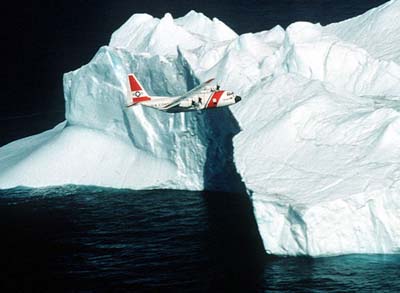
Glaciers: Introduction
It was shortly after midnight on April 15, 1912, when the Titanic struck an iceberg in the North Atlantic. The Titanic was on its maiden voyage from England to New York with more than 2,200 people onboard. After colliding with the iceberg, the ship sank within just two and a half hours, leading to the death of more than 1,500 passengers and crew. The enormity of the tragedy alerted the public to the hazards posed by icebergs. Governments in Europe and America quickly responded, and in 1914 the International Ice Patrol was formed to monitor icebergs in the North Atlantic. In this picture you see one of their planes flying over a large iceberg.
The International Ice Patrol still flies today, keeping close watch of all iceberg activity in the cold waters of the North Atlantic Ocean. In this section, you will learn about the source of icebergs—glaciers. You will learn how and where glaciers form, about their characteristics, and how they give rise to the icebergs that float in open sea waters.